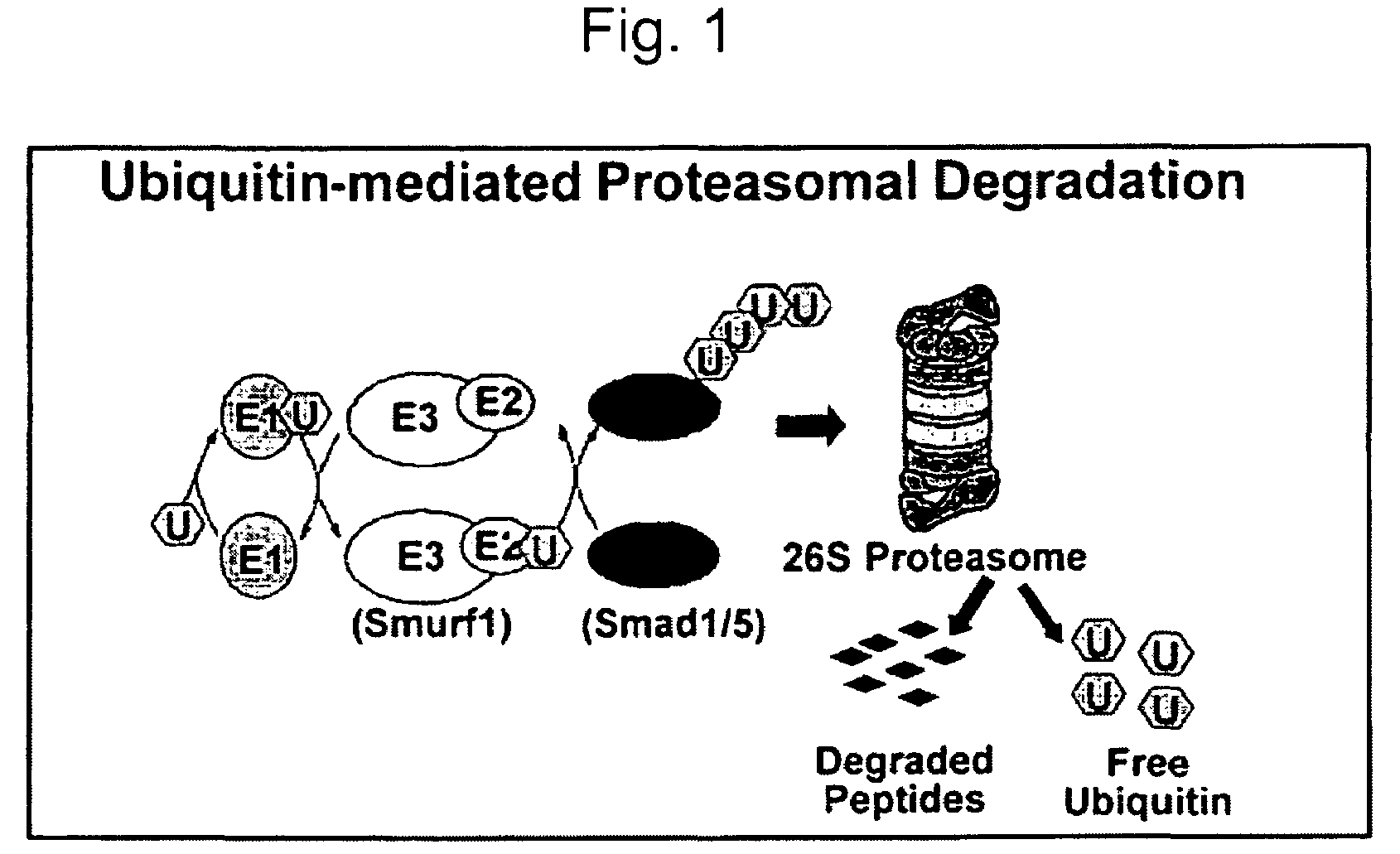Methods and kits using a molecular interaction between a Smurf-1 WW domain and LIM mineralization protein isoforms
a technology of molecular interaction and lim mineralization protein, which is applied in the field of methods and kits for the identification of agents, can solve the problems of increased ubiquitination, less availability of smad proteins for the osteogenic signaling cascade, and high cost of bmp therapy
- Summary
- Abstract
- Description
- Claims
- Application Information
AI Technical Summary
Benefits of technology
Problems solved by technology
Method used
Image
Examples
example 1
Identification of WW-Domain Interacting Motifs in LMP-1
[0094]To corroborate experimental data on bone forming region of LMP-1 sequence with computational motif analysis, we used iSPOT, a web tool useful to infer the recognition specificity of protein module families such as PDZ, SH3 and WW domains. For each of the given family of protein domains, iSPOT evaluates the probability of interaction between a query domain of the specified families and an input protein / peptide sequence. Using the iSPOT server we have analyzed the LMP-1 sequence to identify potential WW domain binding motifs. The iSPOT identified two motifs with binding affinity for WW domains within the 45 amino acid osteogenic region of LMP-1. The motifs, SEQ. ID. NO. 40, ADPPRYTF (0.79) and SEQ. ID. NO. 41, GAPPPADSA (0.61) are predicted to be potential binding sequences with binding affinity for the Smurf1 WW2 domain.
example 2
Comparison of Smurf1 WW2 Domain with Known WW-Domain Structures
[0095]In order to obtain homologous structures of Smurf1-WW2 sequences we have BLASTed this sequence against the protein data bank (PDB) sequences. It can be seen from Table 1 that there are six structures in PDB with significant homology scores. BLAST expectation (E value) scores obtained are less than 4e−5. The bit scores obtained are greater than 40 with the sequence identity greater than 45% for Smurf1-WW2 domain. The sequences of structures 1TK7:A and 1I5H:W showed expectation values (E Value) 2e−9 and 2e−8, and bit scores of 55 and 52, respectively (Table I). We have therefore used these two structures as basis to model the structure of Smurf1-WW2 domain (FIG. 2A & 2B).
[0096]
TABLE IComparison of Smurf1 WW2 domain with known WW-domain structuresavailable in the PDB. The Blast scores are given for each of thesequence compared to the Smurf1-WW2 domain sequence.PDB-IDSeq. ID.PosWW2-domain of SMURF1 homologuesE-Value%Bi...
example 3
Identification of Conserved Amino Acids in the WW2 Domain Sequences
[0097]In order to see conservation profile of amino acid residues in WW2 domain we have multi-aligned all the homologous sequences and computed the conservation index for each amino acid. Table II gives multiple sequence alignment of twenty homologous sequences of WW2 domain region consisting of 35 residues from the NCBI non-redundant (NR) sequence database. All these domains have been proposed to play important role in target protein interactions. The conservation index of each of amino acid is given the Table II. The amino acid residues with conservation index greater than 0.85 (marked + or *) are indicative of playing significant role in maintaining the domain structure.
[0098]
TABLE 2Conservation of amino acids within WW-2domains.PosN-terminal end (up)Index1G G G G G G G G G - G G G G G G G G G G G1.00*2P P P P P P P P P - P A P P P P P P S P P0.88+3L L L L L L L L L L L L L L L L L L L L L1.00*4P P P P P P P P P P...
PUM
| Property | Measurement | Unit |
|---|---|---|
| concentration | aaaaa | aaaaa |
| concentration | aaaaa | aaaaa |
| pH | aaaaa | aaaaa |
Abstract
Description
Claims
Application Information
 Login to View More
Login to View More - R&D
- Intellectual Property
- Life Sciences
- Materials
- Tech Scout
- Unparalleled Data Quality
- Higher Quality Content
- 60% Fewer Hallucinations
Browse by: Latest US Patents, China's latest patents, Technical Efficacy Thesaurus, Application Domain, Technology Topic, Popular Technical Reports.
© 2025 PatSnap. All rights reserved.Legal|Privacy policy|Modern Slavery Act Transparency Statement|Sitemap|About US| Contact US: help@patsnap.com



